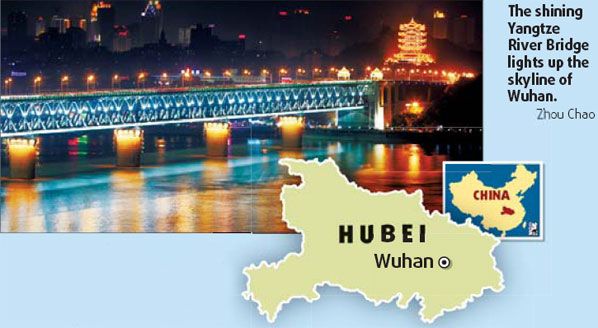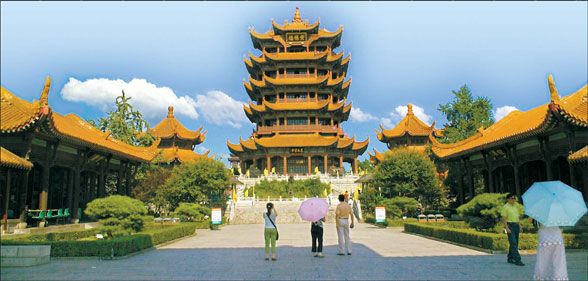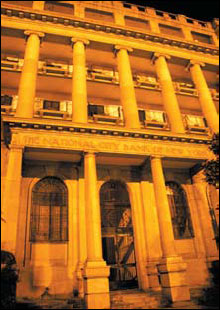Middle Kingdom's Motown
|
The Yellow Crane Tower, built in AD 223, bears witness to the ups and downs of Wuhan. Song Jianchun |
An old man sits on a small stool, with pencil in hand, quietly sketching his local surroundings. He isn't drawing the famous Yangtze River, which seems to attract other Wuhan artists. The local's focus is on one of his city's old foreign buildings, which add so much charm and character to Central China's most populous metropolis.
Wuhan, capital of Hubei province, has a wide, 4-km-long boulevard, which runs along the Yangtze, and just like Shanghai, has many grand-style colonial buildings lining its riverside. The old National City Bank of New York building stands tall and proud, with its classical columns rising high, reflecting America's booming prosperity at the turn of the 20th century. Today this bank is called Citibank, America's largest bank. Opposite, renovated parklands run along the river banks, reflecting China's new prosperity. But in the backstreets, hundreds of smaller buildings echo China's colonial past.
More than 100 years ago, when the Qing Government was sinking into bankruptcy, foreign nations bailed out the declining dynasty with big loans. In return, foreigners were given trading concessions and Wuhan was one of the concession areas. Americans, Germans, Russians, Japanese, French, English and even the Polish, erected big offices and homes trimmed with charming articulation on their facades.
They are scattered everywhere, making Wuhan's downtown roads look a little like Hanoi's bustling backstreets. The Vietnamese capital's French architecture blends exotically with the busy local street life and Wuhan's similar setting paints a unique China picture.
The local government has wisely preserved the architecture and it's only a matter of time before the city's successful urban professionals move into this relatively undeveloped area, bringing with them modern restaurants, shops, bars, coffee shops and their urban cool lifestyles.
Of course, there is much more to this city of 9 million than old foreign buildings. Up to the mid-20th century, Wuhan was comparable to Shanghai and Beijing in manufacturing and educational development. The coastal-oriented reform and opening up policies changed this balance but now Wuhan is catching up and undergoing revitalization.
Wuhan's strategic position in Central China has always made it a major transportation hub, with dozens of railways and roads passing through. It has become the Detroit of China with Citroen, Honda and Nissan cars rolling off production lines at breakneck speed.
|
The National City Bank of New York is one of the old colonial buildings in Wuhan. Patrick Whiteley |
The city links nine provinces and it was no wonder foreigners wanted to set up shop here, in the same way the Chu people did about 3,000 years before. The city name, Wuhan, is relatively new and was only formed in 1927 after the merging of three different cities - Wuchang on the east bank of the river, and Hankou and Hanyang on the western side.
Wuhan is surrounded by busy waterways, mainly the Yangtze and Han rivers, and the famous East Lake. The Wuhan wharves on the Yangtze River are launch pads for many cruises up the river.
The lake is huge and has sandy beach areas, which are packed during the long hot summers. Wuhan temperatures are famous for soaring past 40 C in summer. Narrow roads snake around the mass of water and are lined with drooping trees.
On the lake's southeast side is Moshan Hill, which features the imposing Chutian Tower symbolizing the power of the ancient State of Chu. The Moshan Hill parklands offer a pleasant walk.
Sunsets are soothing and the calming view is best enjoyed from the window of a restaurant overlooking the lake. I tried the "Coming Back Fish", one of Mao Zedong's favorite dishes. The white-colored, freshwater fish gets its name because it follows the cruise boats up to the mouth of the Yangtze near Shanghai, then comes back to Wuhan.
Another favorite local dish is re gan mian or hot dry noodles. The locals enjoy this 4-yuan staple meal for breakfast, however I ate it for lunch and dinner too. A special bean paste gives it a tangy taste. Try Wuhan's famous duck necks too.
For shoppers, Hanzheng Street and the bustling walking street near Hanjiang Road are filled with the latest big-name stores, especially sports clothing outlets. There are running shoes galore, possibly reflecting a city with a spring in its step.
Wuhan has a magnetic mix of old and new and in 1911, the locals started a revolution, which shaped the course of Chinese history. A visit to the old Hubei Military Academy reveals where a new, emperor-free China was declared after Sun Yat-sen's supporters gained victory over the Qing soldiers in the Wuchang Uprising.
A plaque reads: "The feudal monarchy which had lasted for more than 2,000 years ended which opened the gate for China to advance."
From these immaculately-kept army barracks, visitors can look up to a nearby hillside and see another military monument, which has become a national icon. The Yellow Crane Tower was built by Sun Quan in AD 223 during the Three Kingdoms (AD 220-280) and enjoys sweeping views over the river. After hundreds of years, its function as an army watchtower changed into a beacon for great minds and thinkers.
During the Tang Dynasty (AD 618-907), it inspired many classic poems and Yellow Crane Tower established Cui Hao as one of the premier poets of the Tang Dynasty.
The poem is still recited in Chinese schools today.
The tower's guidebook says another famous poet, Li Bai, climbed the tower aiming to write one of his masterpieces, but left without composing one character because he felt so humbled by Cui's poem, which was inscribed on the tower's wall.
The power of the poem is lost when translated in English but in Chinese, the rhythm, rhyme and imagery set a new poetic standard for generations.
Like the tones in Cui's poem, the Yellow Crane Tower has had its ups and downs. During the Ming (1368-1644) and Qing (1644-1911) dynasties alone, the tower was destroyed and rebuilt seven times. In 1884, it was once again burnt to the ground and was not rebuilt until 1981. Today it is Wuhan's most famous tourist site.
Nightlife is also growing and much of the nocturnal activity buzzes on the banks of the Yangtze. Dozens of bars and clubs have sprung up over the past five years.
The Hot and Crazy Sugar Daddy Coffee Shop is a small bar run by a lively fellow who says his Chinese name is Cool Sugar Daddy and his English name is Yellow Sausage. Sugar was a tea trader but swapped corporate life to open a bar. "Wuhan has everything a traveler wants to see in China - great food, a busy nightlife, culture and history, one of China's best universities, temples, rivers and lakes," Sugar says. "But most importantly it has great people as sweet as me," he laughs.

(China Daily 05/23/2008 page19)
















